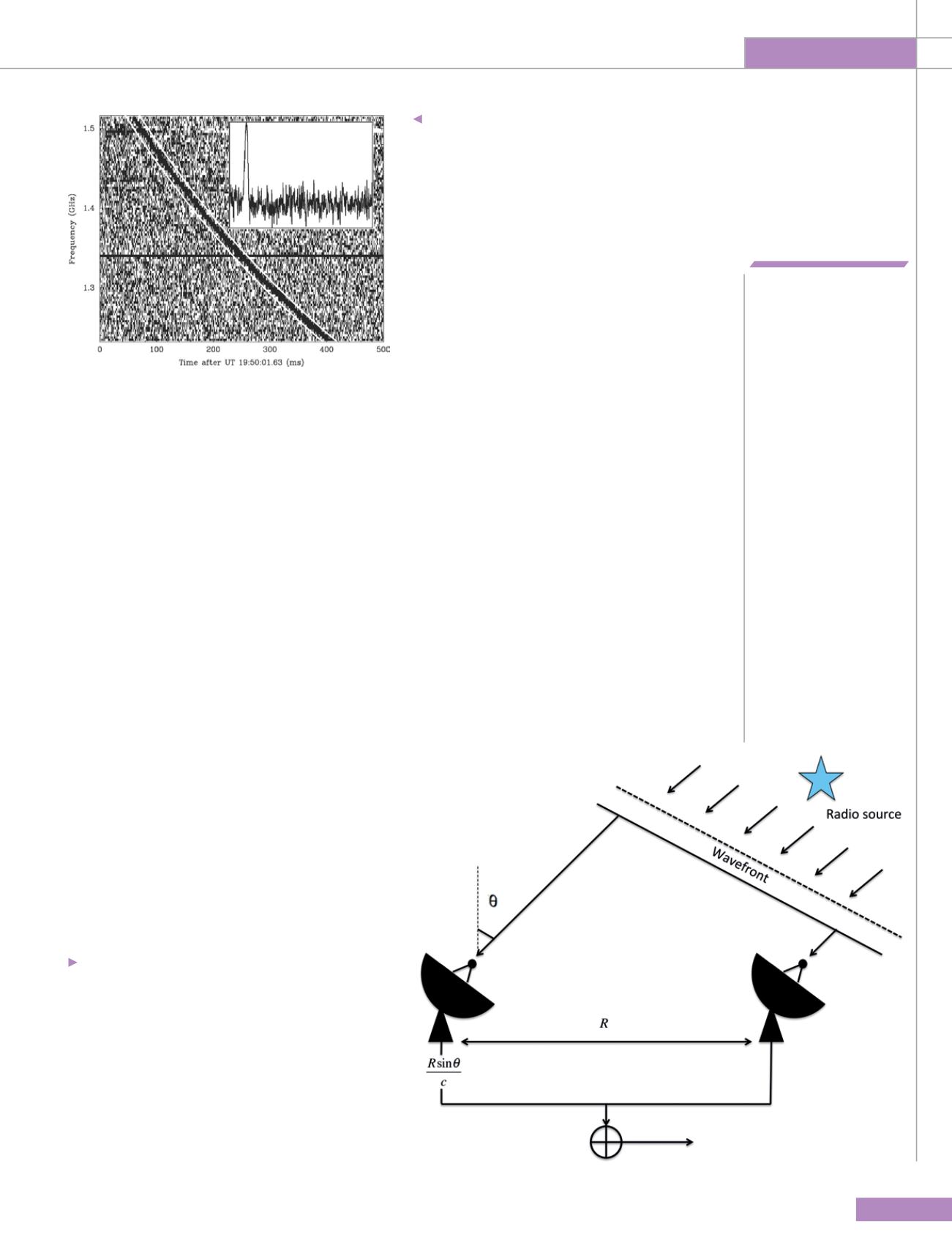
ROOM
81
Space Science
Dispersion sweep of the ‘Lorimer Burst’. The total delay across the entire frequency
band is about half a second. The higher frequencies arrive earlier in time compared to
the lower frequencies resulting in the sweep. The dark line across the plot is a
malfunctioning frequency channel. The white lines on either side of the sweep are
drawn to guide the eye. The sweep of the pulse appears broader at lower frequencies
similar to what is seen in pulsars. The inset shows the integrated sweep and the pulse
is clearly visible above the noise level.
The questions
and theories
outnumbered
the actual
detections and
thus began
the worldwide
race, to
demystify
these FRBs
astrophysical objects at the position in the sky and
no other known sources or emission mechanisms at
that point in time were capable of producing such
extragalactic energetic bursts. Hence it appeared to
represent an entirely new class of radio source.
Primer on FRBs
For years the Lorimer burst was in a class of its
own. It was even suggested that the Lorimer burst
was a freak event possibly due to malfunctioning
electronics at the Parkes telescope or from
man-made interference in the surrounding local
environment. It wasn’t until 2013 that four more
similar bursts were discovered in the archival data
of the High Time Resolution Universe survey at the
Parkes radio telescope and the class ‘Fast Radio
Bursts’ (FRBs) emerged. Fast - because they only
lasted a few milliseconds, radio - because they had
only been seen at this wavelength so far, and burst -
because they appeared and disappeared in a flash.
These new FRBs appeared to be fainter and
much farther away than the Lorimer burst which
made them much more intriguing as, the further
away a source is, the greater its potential of
being a cosmological probe. It then became clear
that whatever these FRBs were, they really were
happening and quite often too.
Early rate estimates suggested that there could
be as many as seven FRBs per minute each coming
from a few billion light-years away and releasing
as much energy as the entire Sun would in a
month to a year, but in just a few milliseconds
of radio energy. Following the discoveries in
2013, rapid advancements minimised the time
lag between the occurrence of the burst and the
time of detection. Astronomers had now entered
the era of real time detections with the time lag
being of order seconds. These real time detections
were a milestone in FRB astronomy and hoped to
provide answers to some of the burning questions.
What was producing these energetic bursts?
Did they occur in galaxies? Did they emit at
other wavelengths? What could they tell us
about the Universe? The questions and theories
outnumbered the actual detections and thus
began the worldwide race to demystify these FRBs.
Why do we care?
They may seem a relatively trivial phenomenon
but understanding FRBs could help researchers
learn a lot about the wider Universe around
us. For one thing, scientists have a problem
with matter; it is known that 95 percent of the
NASA/JPL
Schematic of a simple two element interferometer.
Geometric and instrumental delays due to different path
lengths and cable lengths respectively, are applied to
the input signals of each antenna which are then
coherently summed to yield an improved spatial
resolution on the sky in a tied-array beam. Multiple
tied-array beams are formed by replicating the input
signals from the various antennas and summing them
with the application of different phase offsets, each with
high directivity in a particular direction inside the large
field-of-view. Each beam can now be regarded as an
incoming signal from a single antenna and can be
imparted to the back end for transient searches.


